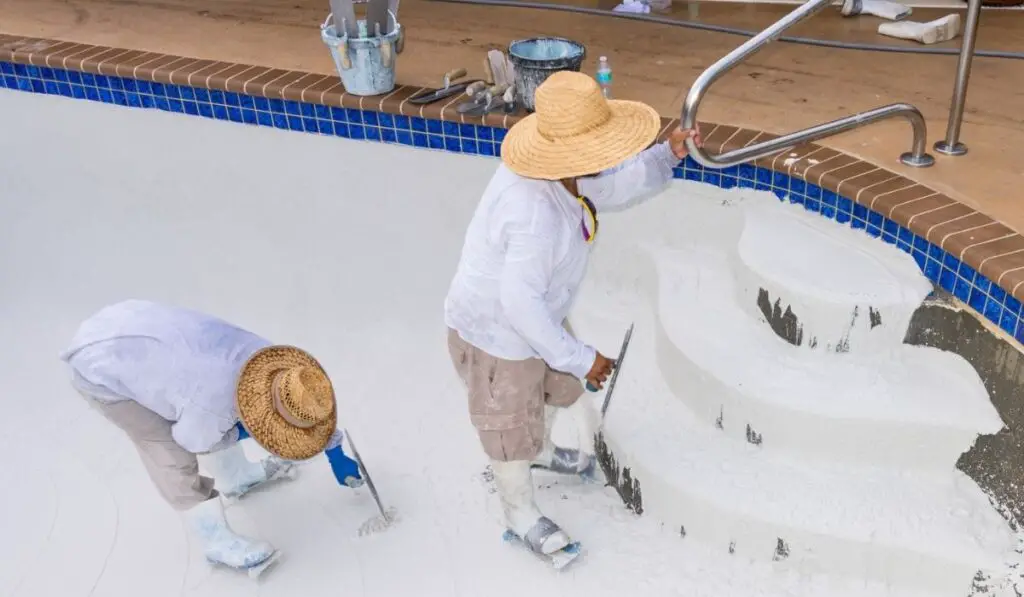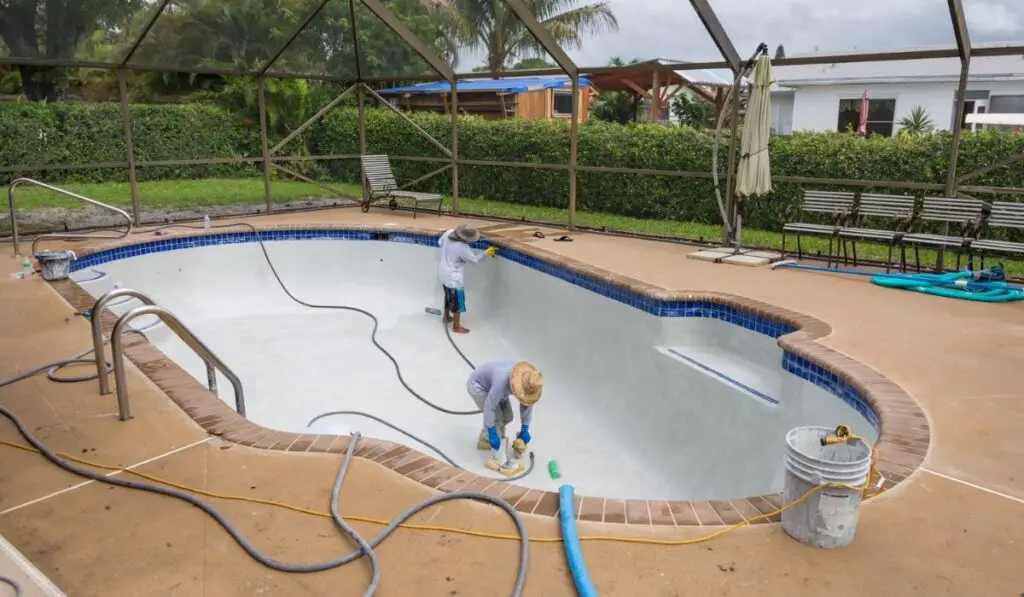Gunite is a popular material used to make customized pools around the world. If you’re looking to build a pool with an intricate design, then look no further than a gunite pool as the best option. Nevertheless, it’s not so easy to maintain a gunite pool, and a common question that comes up is: Do gunite pools need to be resurfaced?
Gunite swimming pools tend to last for 7 to 10 years on average before they need any resurfacing. When it’s time to resurface your gunite pool, consider common finishing materials like aggregate, plaster, and tile. This may be a great time to paint your gunite pool too!
Unfortunately, your gunite pool can’t avoid wear and tear forever, especially when it’s exposed to things like pressurized water, freeze and thaw cycles, and disinfecting chemicals. Let’s look at the basics of pool resurfacing, including why we do it, how, and which options to consider when the time comes.
Why Do Gunite Pools Need to Be Resurfaced?

You should occasionally resurface your gunite pool, and there are a few reasons why. These include:
1. Discoloration of the pool surface: After a couple of years of using a gunite pool, some owners may find some discolorations on the pool surface. Usually, these are mere pool stains.
Several factors can cause stains, including the accumulation of dirt or a build-up of calcium. Failure to get rid of these stains as soon as they appear might result in a need to resurface later on.
2. Swimming discomfort: A lot of gunite pool users have reported that the surfaces of gunite pools are rather rough. Normally, a gunite pool’s surface is tougher than that of fiberglass and vinyl pools.
But, if the pool’s surface gets so rough that it causes injuries (bruises and cuts) to swimmers, resurfacing may be needed. Painting with a thick, epoxy-based paint can help prevent this, or reduce the amount of roughness (by adding a few millimeters thickness of paint).
3. Dirty appearance: If you’ve ever come across a pool that looks particularly rundown, yo’ve got an idea of how pools tend to age. The older your pool gets, the more the cement begins to erode, thereby causing more exposure to the rough surface of the original plaster structure. It also captures dirt and gives the pool a very unhygienic look.
4. To avoid or stop damage: It can be very difficult to clean a pool with old plaster. If there’s a need to have the plaster replaced, the plaster itself comes off the steps and walls and gathers beneath the pool.
The plaster pieces that come off will collect in your filter, creating the need for more frequent filter cleaning, and probably piercing through the cartridges or grids, which can also be expensive to replace.
If the plaster continues to weaken, cracks can form in the structure of the pool, and having cracks fixed could be much more expensive than the cost of regular resurfacing. That’s because the cracks usually go beneath the gunite and the pool structure underneath the plaster layer.
5. Presence of leaks: If you discover that your pool no longer holds water as it should, that is a clear sign that it needs maintenance. If you don’t resurface the pool, it will keep losing water.
In that case, you would need to keep refilling it — and doing so would certainly result in a much higher water bill. Over time, resurfacing your pool is the more cost-effective option. And be sure to consider using an at-home plaster patch kit like this one (on Amazon) to handle some smaller cracks.
How Often Should You Resurface a Gunite Pool?

A lot of gunite pool owners practice will resurface the pool after using it for about four years. However, on average, you can use a gunite pool for 7-10 years before you need to resurface it.
How to Resurface a Gunite Pool
There are different methods of resurfacing gunite pools. However, we recommend that you use the most common finishing materials such as aggregate, plaster, or tile.
How to Clean a Gunite Pool
- Commence with pool draining. As the draining is underway, get rid of any debris that may be floating around.
- Scrub the pool walls. Ensure you scrub off as much dirt and debris as you can.
- Get one gallon of muriatic acid (on Amazon) and another gallon of water. Mix these two, but don’t add the water to the muriatic acid — doing so can be hazardous. Instead, you should add the muriatic acid to the water by gently and carefully pouring it to curb the risk of spillage.
- Spray the entire interior of the pool using a gardening hose. Then you can start pouring your acid and water mixture down the sides of the pool and wait for about thirty seconds to one minute for the acid to do its job.
- Using an acid brush (on Amazon), scrub the area. After a thorough scrub, give it a final wash using your garden hose. Repeat the steps as you work your way around the pool.
- When the acid wash begins to accumulate on the bottom of the pool, add soda ash (on Amazon). In a bid to neutralize it, at least 2 pounds of soda wash for every gallon of acid wash will be needed.
- Use a lot of clean water to rinse the whole pool once again and drain the water in a storm drain. You can then refill the pool and enjoy!
